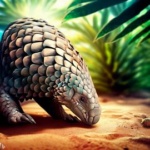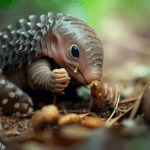Pangolin Reproduction! Pangolins, also known as scaly anteaters, have an intriguing reproductive process. These unique mammals exhibit fascinating behaviors and adaptations that help them successfully reproduce.

Pangolins are solitary creatures, so they spend most of their lives alone. But during mating season, they go on a quest to find a mate. Male pangolins compete fiercely to win over females, showing off their strength and skill through impressive displays of aggression and dominance.
When a male pangolin has won over a female, they start a courtship ritual. This involves vocalizations and scent marking which strengthens the bond between them and helps them communicate better.
After mating, the male takes no part in raising the offspring – it’s the female who takes care of her young. She carries her baby in her womb for several months before giving birth to one pup.
The birth of a pangolin pup is incredible. The newborn is completely helpless and relies on its mother for survival. It clings to her back, learning and adapting to its environment.
To ensure successful reproduction, we must protect pangolin habitats from deforestation and poaching. Plus, we need to implement conservation measures that stop the illegal wildlife trade.
By understanding pangolin reproduction and preserving their natural habitats, we can contribute to safeguarding this amazing species for future generations. Let’s take our role as nature’s stewards seriously and champion conservation efforts to protect these remarkable creatures.
Key Takeaways
- Pangolins have a unique reproductive process that involves internal fertilization and the development of a single offspring.
- Female pangolins have a gestation period of around 4 to 5 months before giving birth to a single baby pangolin.
- Pangolins are born relatively well-developed and are able to cling onto their mother’s back immediately after birth.
- The mother pangolin provides care and protection to her offspring for several months, teaching them essential survival skills.
- Pangolins reach sexual maturity at around 2 to 4 years of age, depending on the species.
- Due to their slow reproductive rate and low birth rate, pangolins are particularly vulnerable to population decline and extinction.
- Conservation efforts should focus on protecting pangolin habitats and implementing measures to combat illegal hunting and trafficking.
Reproduction in Pangolins
Pangolin reproduction is extraordinary! They have a complex mating ritual with dance-like movements and vocalizations. Females carry babies for several months before giving birth to just one. The newborn is independent of an early age, often clinging to their mom. It takes years for them to reach sexual maturity.
We discover more details – pangolins have long gestation periods. Up to six months for the baby to develop in the womb. This gives the baby a better chance to survive.
Once born, the baby needs the mom’s care and protection. But unlike other mammals, this one quickly learns to fend for itself. It grasps Mom’s tail and hitches a ride on her back. This adaptation sets them apart.
To protect these creatures and ensure their reproductive success, we must conserve their habitats and combat illegal wildlife trade. Supporting conservation and spreading awareness will help safeguard pangolins for generations to come. Awww!
Gestation and Birth
Gestation and Birth in pangolins have some unique aspects. Gestation can last from 60 to 150 days. Normally, they give birth to one pup, but sometimes two. Newborns weigh between 300 to 500 grams. Moms provide intensive care for their young until they can become independent.
Pangolins have remarkable adaptations during gestation and birth. Explore their captivating reproductive world and help protect them from illegal wildlife trade. Don’t miss your chance to make a difference! Pangolin parents show an amazingly armored level of adorableness looking after their little ones and teaching them how to roll into a ball.
Parental Care and Offspring Development

Pangolins show amazing parental care skills. They go the extra mile to make sure their young survive and grow.
Females build burrows or nests during the nesting period, to keep their babies safe. They nurse and protect them for an extended period. Moms shield their young from predators and provide essential nutrients. They even curl up around them to regulate the temperature in the nest.
Male pangolins participate in caretaking duties too. Some species help with feeding and grooming the young. Every mom has unique nurturing behaviors. Some are more protective, while others allow more independence.
It’s clear that pangolins have an innate ability to raise their young with dedication. To keep them alive, we must conserve their habitats and protect their existence. Let’s work together to conserve natural ecosystems and ensure the thriving of these unique creatures for future generations.
Threats and Conservation Efforts
Pangolins, otherwise known as scaly anteaters, are facing many dangers. Conservation projects have been set up to save these unique creatures and ensure their continued existence.

- Poaching: Pangolins are hunted for their scales. These are believed to have medicinal qualities, thus driving poachers to hunt them.
- Habitat Loss: The destruction of pangolin habitats due to deforestation and urbanization is a huge issue. These animals need specific environments for food and shelter.
- Illegal Trade: The global demand for pangolins has led to illegal trade, making them one of the most trafficked mammals. This is a serious threat to their population.
These are some of the conservation efforts:
- International Cooperation: Countries are joining forces to tackle illegal trade and put stricter regulations in place.
- Preserving Habitats: To give pangolins a suitable environment, efforts are being made to protect and restore their habitats.
- Raising Awareness: Educational campaigns are informing the public about the importance of conserving pangolins. People are being discouraged from consuming their products and encouraged to be responsible tourists.
These attempts will help secure the future of pangolins, and allow for them to remain for coming generations.
Pro Tip: You can help too! Donate or volunteer your time to organizations that support pangolin conservation. Every bit counts in safeguarding these amazing creatures. If that’s not enough, just remember that pangolins reproduce in a way that would astound any magician!
Frequently Asked Questions
1. How does pangolin reproduction occur?
Pangolins reproduce sexually, with the male and female engaging in a courtship ritual before mating.
2. How often do pangolins give birth?
Pangolins typically give birth once a year, although some species may have longer intervals between pregnancies.
3. How many babies do pangolins have at a time?
Pangolins usually have only one baby at a time, although rare cases of twins have been observed.
4. How long is the gestation period for pangolins?
The gestation period for pangolins ranges from 70 to 140 days, depending on the species.
5. Do pangolins provide parental care to their young?
Yes, pangolins provide parental care to their young. The mother carries the baby on her tail or back and nurses it until it is able to forage on its own.
6. Are pangolins endangered due to their reproductive habits?
No, pangolins are primarily endangered due to habitat loss and illegal poaching for their scales and meat, rather than their reproductive habits.
Conclusion
Studying pangolins’ reproduction offers us insight into their one-of-a-kind reproductive tactics. These amazing animals use physical adaptations and behavior patterns to ensure successful procreation. Pangolins usually produce one baby per pregnancy and have picky mating behaviors. These help keep their species alive.
One extraordinary element of pangolins’ reproductive system is that females often give birth to only one offspring. This low rate is made up for by the parents investing a lot in each baby, ensuring it survives and can reproduce.
Pangolins also have selective breeding habits, choosing mates based on size, strength, or territory. This ensures the strongest individuals are able to reproduce, creating genetically diverse and versatile populations.
An interesting story comes from the field which shows the significance of understanding pangolin reproduction. Once, researchers saw a mother pangolin fighting hard to protect her baby from a potential predator. Even though she was outnumbered and at risk, she kept fighting until help came. This excellent display of maternal instinct demonstrates the tight bond between pangolin parents and offspring.




